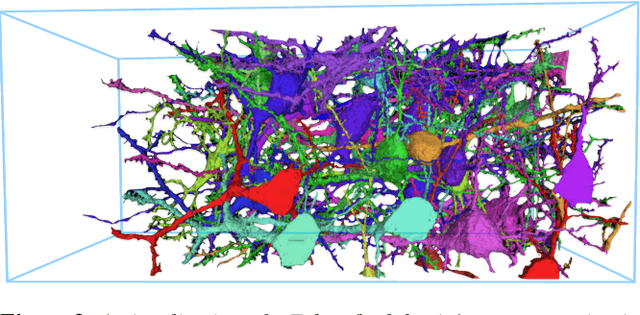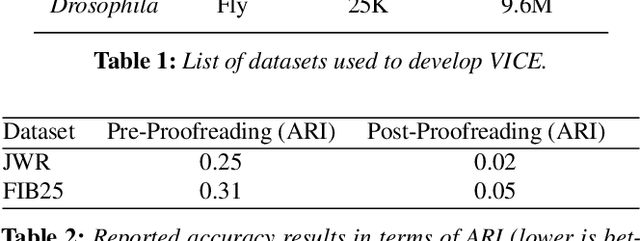Markus Hadwiger
SAM4EM: Efficient memory-based two stage prompt-free segment anything model adapter for complex 3D neuroscience electron microscopy stacks
Apr 30, 2025Abstract:We present SAM4EM, a novel approach for 3D segmentation of complex neural structures in electron microscopy (EM) data by leveraging the Segment Anything Model (SAM) alongside advanced fine-tuning strategies. Our contributions include the development of a prompt-free adapter for SAM using two stage mask decoding to automatically generate prompt embeddings, a dual-stage fine-tuning method based on Low-Rank Adaptation (LoRA) for enhancing segmentation with limited annotated data, and a 3D memory attention mechanism to ensure segmentation consistency across 3D stacks. We further release a unique benchmark dataset for the segmentation of astrocytic processes and synapses. We evaluated our method on challenging neuroscience segmentation benchmarks, specifically targeting mitochondria, glia, and synapses, with significant accuracy improvements over state-of-the-art (SOTA) methods, including recent SAM-based adapters developed for the medical domain and other vision transformer-based approaches. Experimental results indicate that our approach outperforms existing solutions in the segmentation of complex processes like glia and post-synaptic densities. Our code and models are available at https://github.com/Uzshah/SAM4EM.
VICE: Visual Identification and Correction of Neural Circuit Errors
May 14, 2021



Abstract:A connectivity graph of neurons at the resolution of single synapses provides scientists with a tool for understanding the nervous system in health and disease. Recent advances in automatic image segmentation and synapse prediction in electron microscopy (EM) datasets of the brain have made reconstructions of neurons possible at the nanometer scale. However, automatic segmentation sometimes struggles to segment large neurons correctly, requiring human effort to proofread its output. General proofreading involves inspecting large volumes to correct segmentation errors at the pixel level, a visually intensive and time-consuming process. This paper presents the design and implementation of an analytics framework that streamlines proofreading, focusing on connectivity-related errors. We accomplish this with automated likely-error detection and synapse clustering that drives the proofreading effort with highly interactive 3D visualizations. In particular, our strategy centers on proofreading the local circuit of a single cell to ensure a basic level of completeness. We demonstrate our framework's utility with a user study and report quantitative and subjective feedback from our users. Overall, users find the framework more efficient for proofreading, understanding evolving graphs, and sharing error correction strategies.
Cavlectometry: Towards Holistic Reconstruction of Large Mirror Objects
Sep 14, 2014



Abstract:We introduce a method based on the deflectometry principle for the reconstruction of specular objects exhibiting significant size and geometric complexity. A key feature of our approach is the deployment of an Automatic Virtual Environment (CAVE) as pattern generator. To unfold the full power of this extraordinary experimental setup, an optical encoding scheme is developed which accounts for the distinctive topology of the CAVE. Furthermore, we devise an algorithm for detecting the object of interest in raw deflectometric images. The segmented foreground is used for single-view reconstruction, the background for estimation of the camera pose, necessary for calibrating the sensor system. Experiments suggest a significant gain of coverage in single measurements compared to previous methods. To facilitate research on specular surface reconstruction, we will make our data set publicly available.
 Add to Chrome
Add to Chrome Add to Firefox
Add to Firefox Add to Edge
Add to Edge